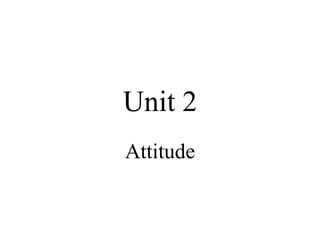
Understanding how attitudes form and change
- 2. Topics to be covered • Components • Change of Attitude
- 3. Attitude Meaning • An “attitude” is defined as a person’s tendency to behave and feel in a particular way toward some object. • Example: Students avoid studying difficult subjects like Statistics or Mathematics. They have a negative attitude towards it. • Example: Students coming late for theory class because they have a casual attitude towards the subject.
- 4. Attitudes are characterized in three ways: • First: they tend to continue unless something is done to change them. – For example: Making subjects easy to understand. Or attaching the relevance of attendance with the theory subject. It can change students’ attitude • Second: Attitudes can fall anywhere along a continuum from very favorable to unfavorable. – Changing class timing or making subject fun to learn can moderate students’ attitude from negative to favorable. • Third: Attitudes are directed towards some object about which a person has feelings. – For example: Students like to play and enjoy their mobile phones instead of listening to theory lectures.
- 5. Components of Attitude • Cognition: Evaluation of something. – Student getting full marks however deserves less. • Affect: Feeling – Student continuously scolded by faculty, reciprocates that faculty hates student. • Behavior: Action – Student complain against the faculty or change college.
- 6. Change of Attitudes • Individuals want consistency in their attitude and behavior. • To change attitude they have to change their behavior also. • Two theories were propounded for establishing the relationship between attitude and behavior. – Cognitive dissonance theory – Self perception theory
- 7. Cognitive Dissonance Theory • Proposed by Leon Festinger in 1950s. • “Cognitive dissonance” means any inconsistency (irregularity) perceived by an individual between two or more attitudes, or between behavior and attitude. • Any form of inconsistency is uncomfortable and that individuals will attempt to reduce the dissonance and discomfort. Thus, individuals will seek a stable state in which there is a minimum of dissonance (conflict). • Like cheating of income tax is not possible so people play with numbers.
- 8. Dissonance can be reduced by three attributes I. Importance: Importance of elements creating conflict. Example: If students have to pass then they have to change their attitude towards the subject and study it. Or if attendance is important then students will come on time. II. Degree of influence: Impact of elements on individuals. Example: Marks, CGPA, Money. III. Rewards: Rewards influence the degree to which individuals are motivated to reduce the dissonance. Example: Appreciation from Parents and faculty members
- 9. Self Perception Theory • Just opposite of Cognitive dissonance theory. • Here behavior affects or changes the attitude of individual. • Attitudes are developed on the basis of outcome of a behavior. – For example: Coming class on time helps in attaining full attendance. So attitude becomes positive and careful about reaching on class on time.
- 10. Changing attitudes in Workplace • Set ideals or examples for employees • Identify motivators (goals or rewards) • Eliminate troublemakers • Proper ambience • Recognition • Support
